python复杂网络分析库NetworkX
NetworkX是一个用Python语言开发的图论与复杂网络建模工具,内置了常用的图与复杂网络分析算法,可以方便的进行复杂网络数据分析、仿真建模等工作。networkx支持创建简单无向图、有向图和多重图(multigraph);内置许多标准的图论算法,节点可为任意数据;支持任意的边值维度,功能丰富,简单易用。
引入模块
import networkx as nx print nx
无向图
例1:
#!-*- coding:utf8-*- import networkx as nx import matplotlib.pyplot as plt G = nx.Graph() #建立一个空的无向图G G.add_node(1) #添加一个节点1 G.add_edge(2,3) #添加一条边2-3(隐含着添加了两个节点2、3) G.add_edge(3,2) #对于无向图,边3-2与边2-3被认为是一条边 print "nodes:", G.nodes() #输出全部的节点: [1, 2, 3] print "edges:", G.edges() #输出全部的边:[(2, 3)] print "number of edges:", G.number_of_edges() #输出边的数量:1 nx.draw(G) plt.savefig("wuxiangtu.png") plt.show()
输出
nodes: [1, 2, 3] edges: [(2, 3)] number of edges: 1

例2:
#-*- coding:utf8-*- import networkx as nx import matplotlib.pyplot as plt G = nx.DiGraph() G.add_node(1) G.add_node(2) #加点 G.add_nodes_from([3,4,5,6]) #加点集合 G.add_cycle([1,2,3,4]) #加环 G.add_edge(1,3) G.add_edges_from([(3,5),(3,6),(6,7)]) #加边集合 nx.draw(G) plt.savefig("youxiangtu.png") plt.show()
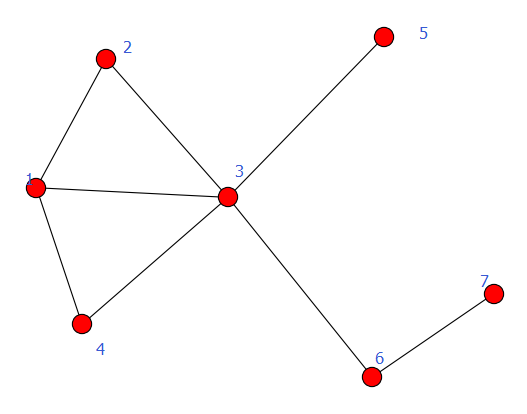
有向图
例1:
#!-*- coding:utf8-*- import networkx as nx import matplotlib.pyplot as plt G = nx.DiGraph() G.add_node(1) G.add_node(2) G.add_nodes_from([3,4,5,6]) G.add_cycle([1,2,3,4]) G.add_edge(1,3) G.add_edges_from([(3,5),(3,6),(6,7)]) nx.draw(G) plt.savefig("youxiangtu.png") plt.show()
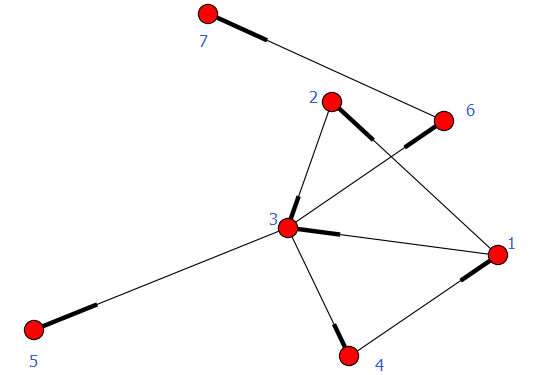
注:有向图和无向图可以互相转换,使用函数:
- Graph.to_undirected()
- Graph.to_directed()
例2,例子中把有向图转化为无向图:
#!-*- coding:utf8-*- import networkx as nx import matplotlib.pyplot as plt G = nx.DiGraph() G.add_node(1) G.add_node(2) G.add_nodes_from([3,4,5,6]) G.add_cycle([1,2,3,4]) G.add_edge(1,3) G.add_edges_from([(3,5),(3,6),(6,7)]) G = G.to_undirected() nx.draw(G) plt.savefig("wuxiangtu.png") plt.show()
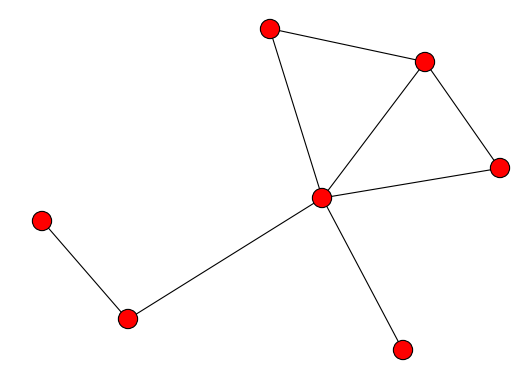
注意区分以下2例
例3-1
#-*- coding:utf8-*- import networkx as nx import matplotlib.pyplot as plt G = nx.DiGraph() road_nodes = {'a': 1, 'b': 2, 'c': 3} #road_nodes = {'a':{1:1}, 'b':{2:2}, 'c':{3:3}} road_edges = [('a', 'b'), ('b', 'c')] G.add_nodes_from(road_nodes.iteritems()) G.add_edges_from(road_edges) nx.draw(G) plt.savefig("youxiangtu.png") plt.show()
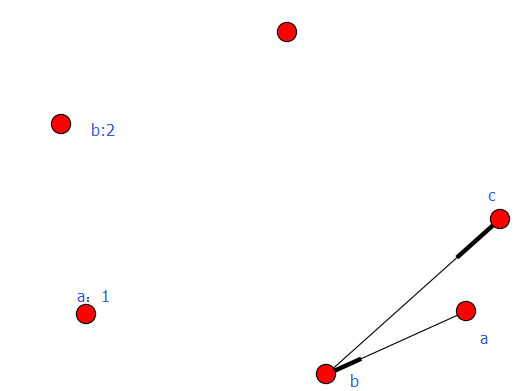
例3-2
#-*- coding:utf8-*- import networkx as nx import matplotlib.pyplot as plt G = nx.DiGraph() #road_nodes = {'a': 1, 'b': 2, 'c': 3} road_nodes = {'a':{1:1}, 'b':{2:2}, 'c':{3:3}} road_edges = [('a', 'b'), ('b', 'c')] G.add_nodes_from(road_nodes.iteritems()) G.add_edges_from(road_edges) nx.draw(G) plt.savefig("youxiangtu.png") plt.show()
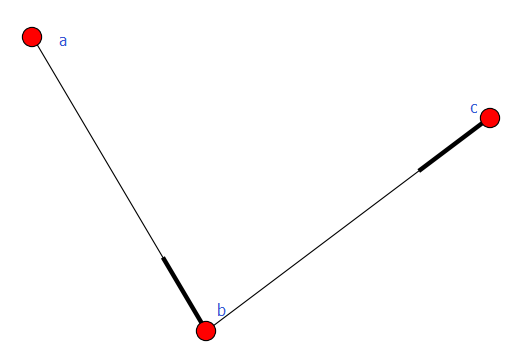
加权图
有向图和无向图都可以给边赋予权重,用到的方法是add_weighted_edges_from,它接受1个或多个三元组[u,v,w]作为参数,其中u是起点,v是终点,w是权重。
例1:
#!-*- coding:utf8-*- import networkx as nx import matplotlib.pyplot as plt G = nx.Graph() #建立一个空的无向图G G.add_edge(2,3) #添加一条边2-3(隐含着添加了两个节点2、3) G.add_weighted_edges_from([(3, 4, 3.5),(3, 5, 7.0)]) #对于无向图,边3-2与边2-3被认为是一条边 print G.get_edge_data(2, 3) print G.get_edge_data(3, 4) print G.get_edge_data(3, 5) nx.draw(G) plt.savefig("wuxiangtu.png") plt.show()
输出
{} {'weight': 3.5} {'weight': 7.0}
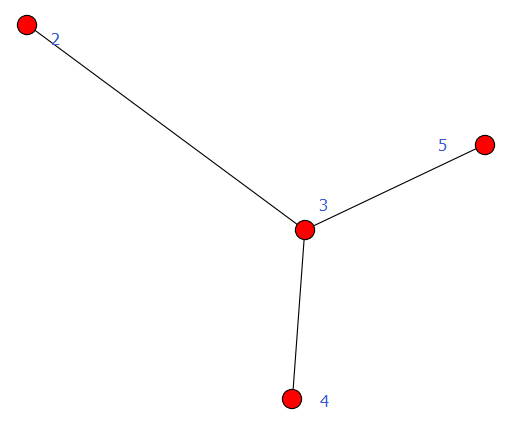
经典图论算法计算
计算1:求无向图的任意两点间的最短路径
# -*- coding: cp936 -*- import networkx as nx import matplotlib.pyplot as plt #计算1:求无向图的任意两点间的最短路径 G = nx.Graph() G.add_edges_from([(1,2),(1,3),(1,4),(1,5),(4,5),(4,6),(5,6)]) path = nx.all_pairs_shortest_path(G) print path[1]
计算2:找图中两个点的最短路径
import networkx as nx G=nx.Graph() G.add_nodes_from([1,2,3,4]) G.add_edge(1,2) G.add_edge(3,4) try: n=nx.shortest_path_length(G,1,4) print n except nx.NetworkXNoPath: print 'No path'
强连通、弱连通
- 强连通:有向图中任意两点v1、v2间存在v1到v2的路径(path)及v2到v1的路径。
- 弱联通:将有向图的所有的有向边替换为无向边,所得到的图称为原图的基图。如果一个有向图的基图是连通图,则有向图是弱连通图。
距离
例1:弱连通
#-*- coding:utf8-*- import networkx as nx import matplotlib.pyplot as plt #G = nx.path_graph(4, create_using=nx.Graph()) #0 1 2 3 G = nx.path_graph(4, create_using=nx.DiGraph()) #默认生成节点0 1 2 3,生成有向变0->1,1->2,2->3 G.add_path([7, 8, 3]) #生成有向边:7->8->3 for c in nx.weakly_connected_components(G): print c print [len(c) for c in sorted(nx.weakly_connected_components(G), key=len, reverse=True)] nx.draw(G) plt.savefig("youxiangtu.png") plt.show()
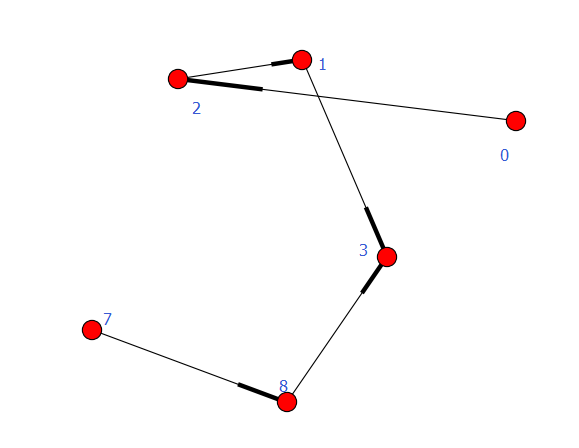
执行结果
set([0, 1, 2, 3, 7, 8])
[6]
例2:强连通
#-*- coding:utf8-*- import networkx as nx import matplotlib.pyplot as plt #G = nx.path_graph(4, create_using=nx.Graph()) #0 1 2 3 G = nx.path_graph(4, create_using=nx.DiGraph()) G.add_path([3, 8, 1]) #for c in nx.strongly_connected_components(G): # print c # #print [len(c) for c in sorted(nx.strongly_connected_components(G), key=len, reverse=True)] con = nx.strongly_connected_components(G) print con print type(con) print list(con) nx.draw(G) plt.savefig("youxiangtu.png") plt.show()
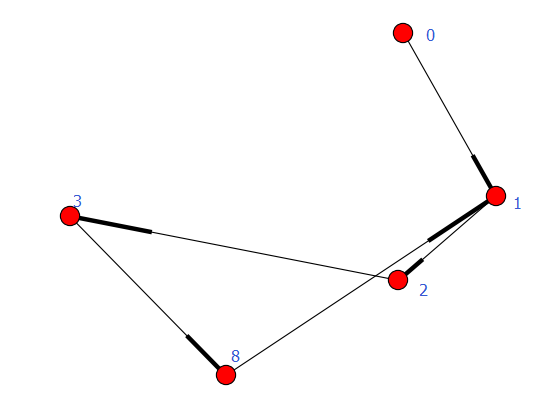
执行结果
<generator object strongly_connected_components at 0x0000000008AA1D80> <type 'generator'> [set([8, 1, 2, 3]), set([0])]
子图
#-*- coding:utf8-*- import networkx as nx import matplotlib.pyplot as plt G = nx.DiGraph() G.add_path([5, 6, 7, 8]) sub_graph = G.subgraph([5, 6, 8]) #sub_graph = G.subgraph((5, 6, 8)) #ok 一样 nx.draw(sub_graph) plt.savefig("youxiangtu.png") plt.show()
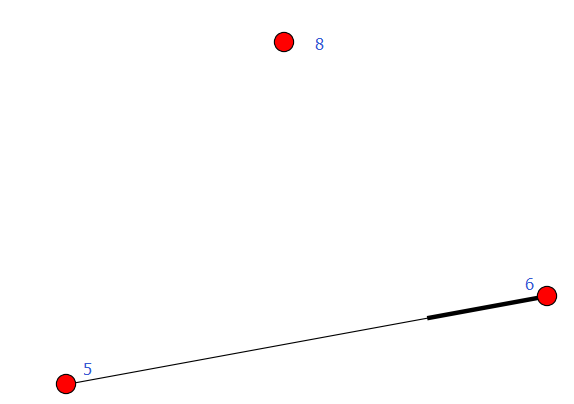
条件过滤
#原图
#-*- coding:utf8-*- import networkx as nx import matplotlib.pyplot as plt G = nx.DiGraph() road_nodes = {'a':{'id':1}, 'b':{'id':1}, 'c':{'id':3}, 'd':{'id':4}} road_edges = [('a', 'b'), ('a', 'c'), ('a', 'd'), ('b', 'd')] G.add_nodes_from(road_nodes) G.add_edges_from(road_edges) nx.draw(G) plt.savefig("youxiangtu.png") plt.show()
图
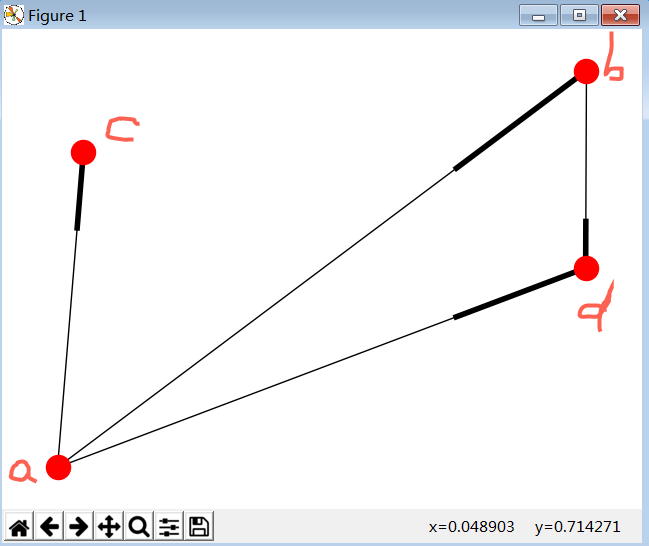
#过滤函数
#-*- coding:utf8-*- import networkx as nx import matplotlib.pyplot as plt G = nx.DiGraph() def flt_func_draw(): flt_func = lambda d: d['id'] != 1 return flt_func road_nodes = {'a':{'id':1}, 'b':{'id':1}, 'c':{'id':3}, 'd':{'id':4}} road_edges = [('a', 'b'), ('a', 'c'), ('a', 'd'), ('b', 'd')] G.add_nodes_from(road_nodes.iteritems()) G.add_edges_from(road_edges) flt_func = flt_func_draw() part_G = G.subgraph(n for n, d in G.nodes_iter(data=True) if flt_func(d)) nx.draw(part_G) plt.savefig("youxiangtu.png") plt.show()
图

pred,succ
#-*- coding:utf8-*- import networkx as nx import matplotlib.pyplot as plt G = nx.DiGraph() road_nodes = {'a':{'id':1}, 'b':{'id':1}, 'c':{'id':3}} road_edges = [('a', 'b'), ('a', 'c'), ('c', 'd')] G.add_nodes_from(road_nodes.iteritems()) G.add_edges_from(road_edges) print G.nodes() print G.edges() print "a's pred ", G.pred['a'] print "b's pred ", G.pred['b'] print "c's pred ", G.pred['c'] print "d's pred ", G.pred['d'] print "a's succ ", G.succ['a'] print "b's succ ", G.succ['b'] print "c's succ ", G.succ['c'] print "d's succ ", G.succ['d'] nx.draw(G) plt.savefig("wuxiangtu.png") plt.draw()
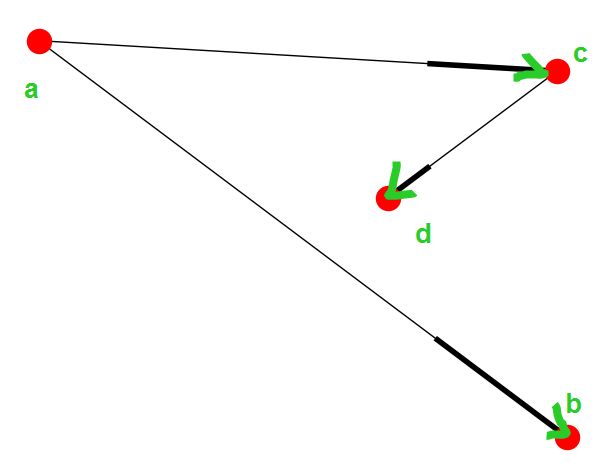
结果
['a', 'c', 'b', 'd']
[('a', 'c'), ('a', 'b'), ('c', 'd')]
a's pred {}
b's pred {'a': {}}
c's pred {'a': {}}
d's pred {'c': {}}
a's succ {'c': {}, 'b': {}}
b's succ {}
c's succ {'d': {}}
d's succ {}




 浙公网安备 33010602011771号
浙公网安备 33010602011771号